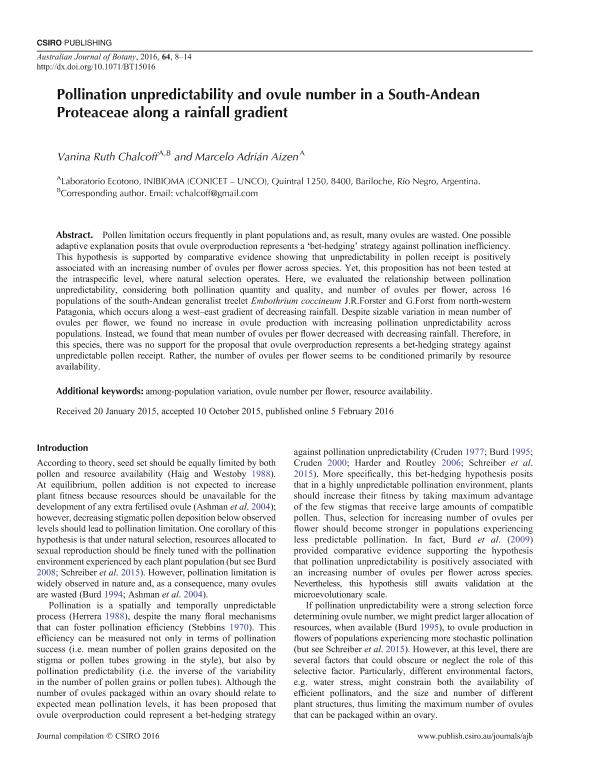Artículo
Pollination unpredictability and ovule number in a South-Andean Proteaceae along a rainfall gradient
Fecha de publicación:
02/2016
Editorial:
Csiro Publishing
Revista:
Australian Journal of Botany
ISSN:
0067-1924
Idioma:
Inglés
Tipo de recurso:
Artículo publicado
Clasificación temática:
Resumen
Pollen limitation occurs frequently in plant populations and, as result, many ovules are wasted. One possible adaptive explanation posits that ovule overproduction represents a 'bet-hedging' strategy against pollination inefficiency. This hypothesis is supported by comparative evidence showing that unpredictability in pollen receipt is positively associated with an increasing number of ovules per flower across species. Yet, this proposition has not been tested at the intraspecific level, where natural selection operates. Here, we evaluated the relationship between pollination unpredictability, considering both pollination quantity and quality, and number of ovules per flower, across 16 populations of the south-Andean generalist treelet Embothrium coccineum J.R.Forster and G.Forst from north-western Patagonia, which occurs along a west-east gradient of decreasing rainfall. Despite sizable variation in mean number of ovules per flower, we found no increase in ovule production with increasing pollination unpredictability across populations. Instead, we found that mean number of ovules per flower decreased with decreasing rainfall. Therefore, in this species, there was no support for the proposal that ovule overproduction represents a bet-hedging strategy against unpredictable pollen receipt. Rather, the number of ovules per flower seems to be conditioned primarily by resource availability.
Archivos asociados
Licencia
Identificadores
Colecciones
Articulos(INIBIOMA)
Articulos de INST. DE INVEST.EN BIODIVERSIDAD Y MEDIOAMBIENTE
Articulos de INST. DE INVEST.EN BIODIVERSIDAD Y MEDIOAMBIENTE
Citación
Chalcoff, Vanina Ruth; Aizen, Marcelo Adrian; Pollination unpredictability and ovule number in a South-Andean Proteaceae along a rainfall gradient; Csiro Publishing; Australian Journal of Botany; 64; 1; 2-2016; 8-14
Compartir
Altmétricas




